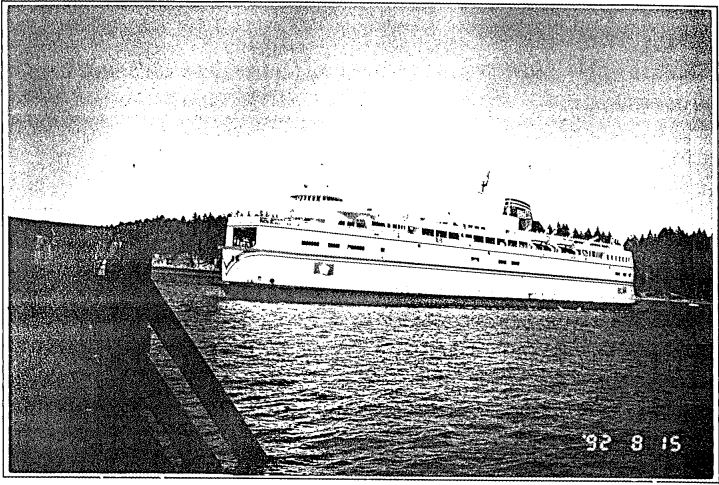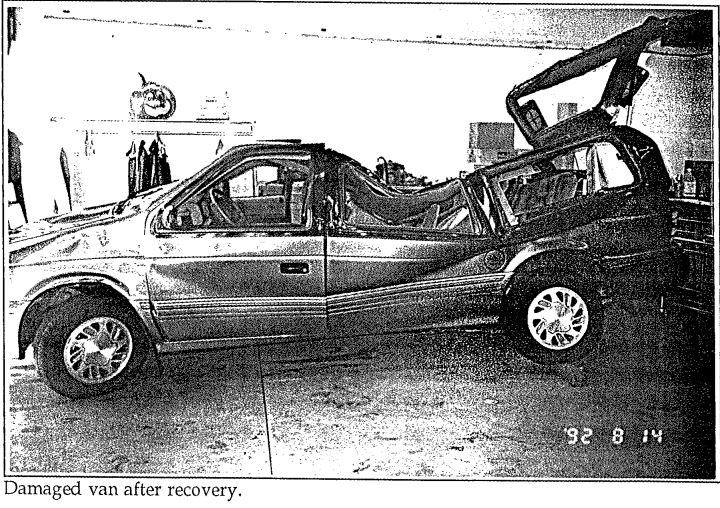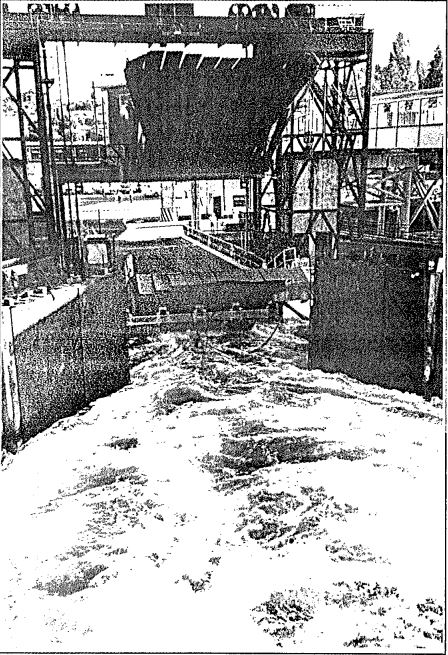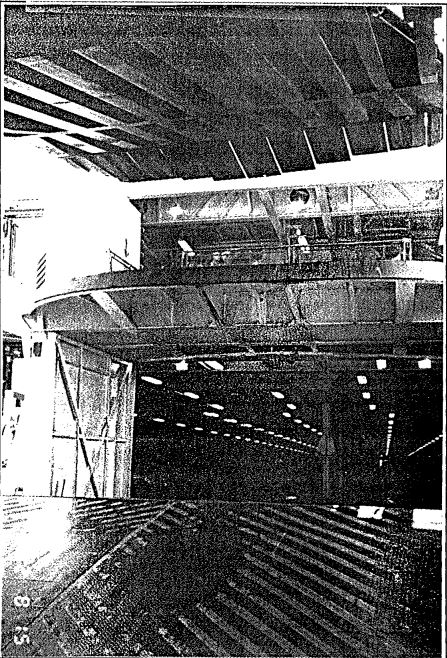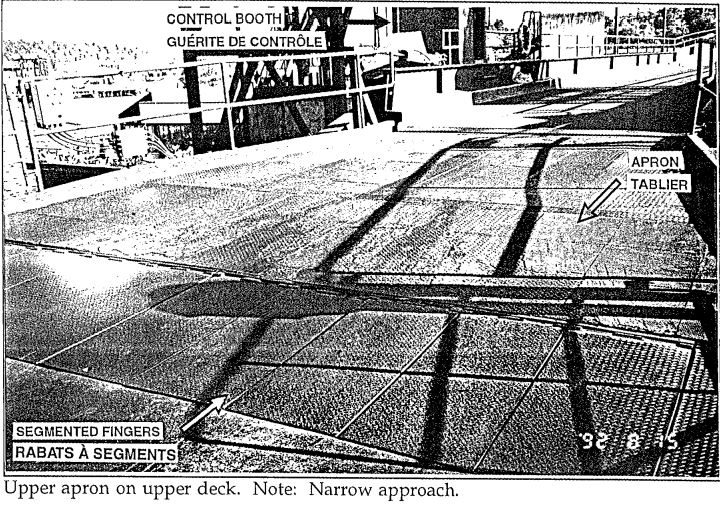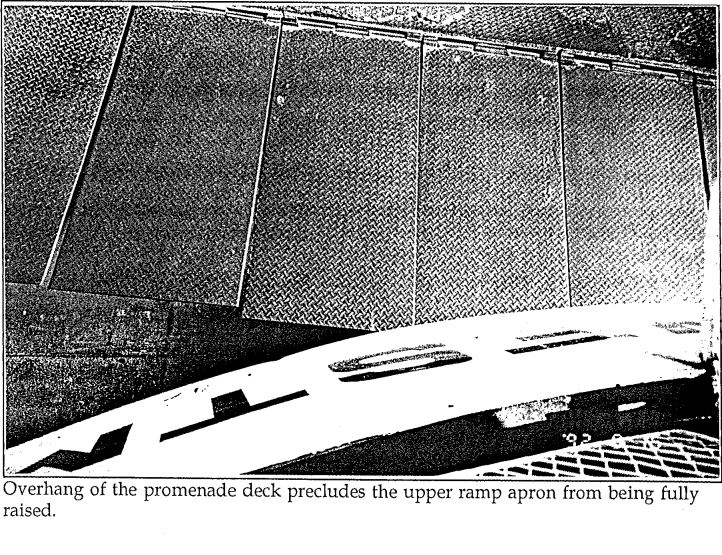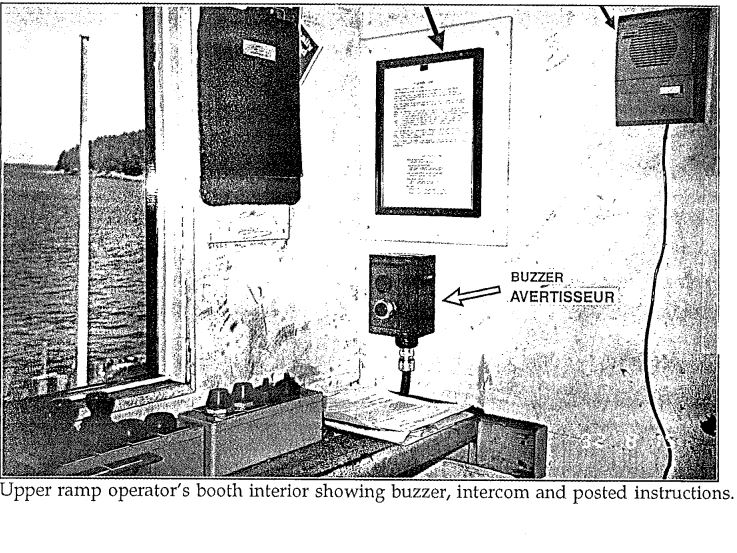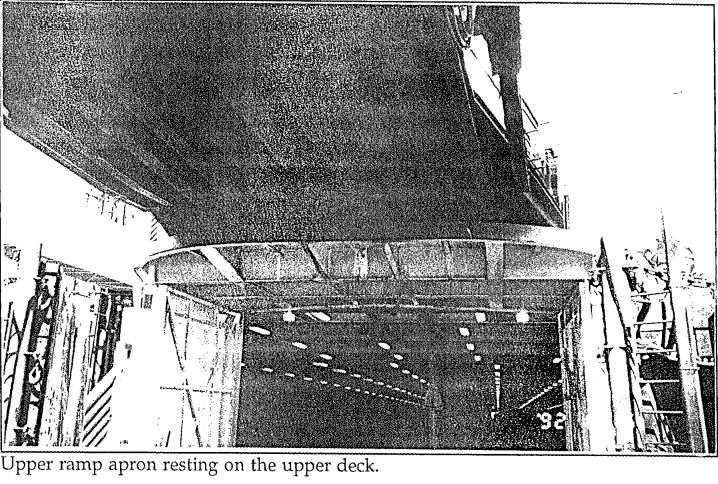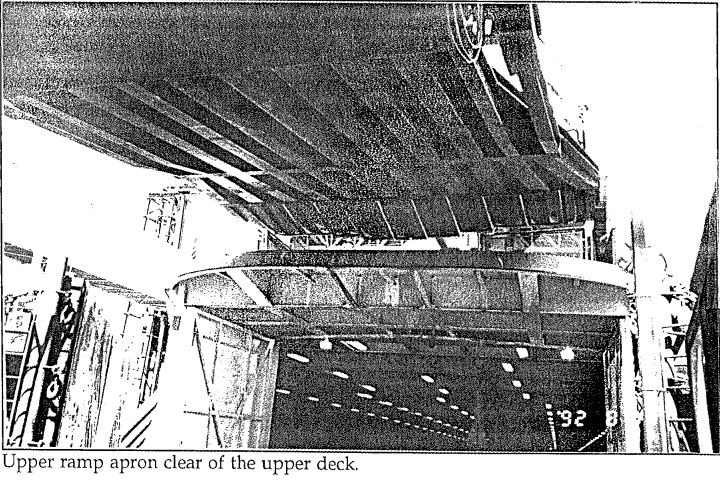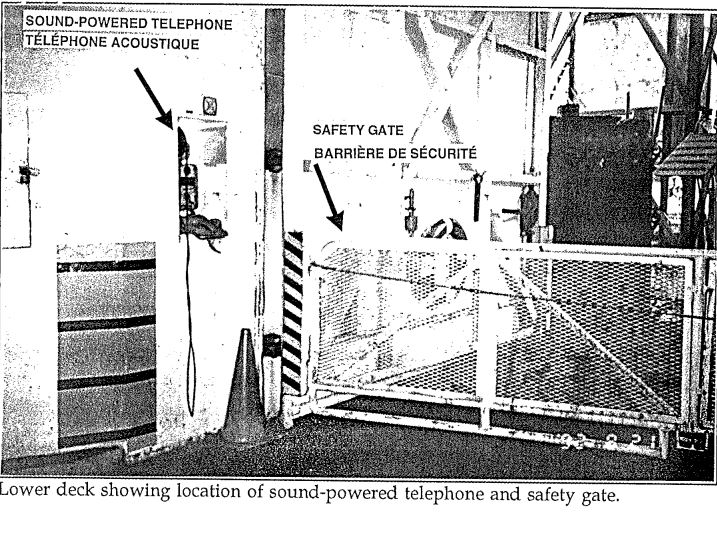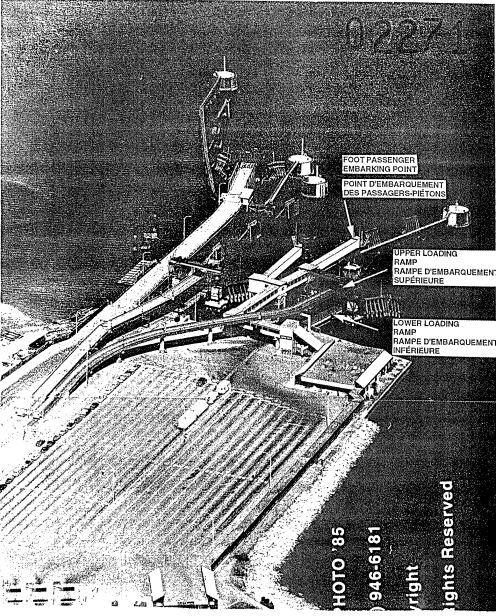Fatal accident to passenger vehicle involving
the Ferry "QUEEN OF NEW WESTMINSTER"
Departure Bay, British Columbia
The Transportation Safety Board of Canada (TSB) investigated this occurrence for the purpose of advancing transportation safety. It is not the function of the Board to assign fault or determine civil or criminal liability. This report is not created for use in the context of legal, disciplinary or other proceedings. See Ownership and use of content.
Table of contents
Summary
The "QUEEN OF NEW WESTMINSTER" was docked at No. 3 berth in Departure Bay, British Columbia (B.C.) on 13 August 1992. During the final stages of vehicle loading on the upper deck aboard the "QUEEN OF NEW WESTMINSTER", a van with six occupants was directed to stop. While the van was stopped on the apron of the shore loading ramp, the ferry began to pull away from the berth. The apron lost the support of the ferry deck causing the van to fall onto the ferry's lower deck and then into the water. As a result of this accident, three of the occupants died and three were recovered safely from the water, one having received serious injuries.
The Board determined that established clearance procedures were not followed and the ferry departed prematurely from the berth. Contributing to this occurrence were the shore and shipboard personnel's preoccupation with maintaining the ferry schedule and communication problems associated with the use of portable radios by terminal personnel.
1.0 Factual Information
1.1 Particulars of the Vessel
| Name | "QUEEN OF NEW WESTMINSTER" |
|---|---|
| Official number | 322953 |
| Port of registry | Victoria, B.C. |
| Flag | Canadian |
| Type | Ro/Ro1 passenger/vehicle ferry, capable of carrying 286 vehicles and 1,360 passengers |
| Built | 1964, Victoria, B.C. |
| Gross Tons | 8,785.8 |
| Length | 129.98 m |
| Breadth | 23.93 m |
| Draught max.(at time of occurrence) | F: 4.07 m A: 3.89 m |
| Propulsion | Four Wartsila 9R-32D diesels, developing 3,375 kW each, driving two controllable-pitch propellers |
| Owners | British Columbia Ferry Corp. (BCFC), Victoria, B.C. |
1 See Glossary for all abbreviations and acronyms.
2 Units of measurement in this report conform to International Maritime Organization (IMO) standards or, where there is no such standard, are expressed in the International System (SI) of units.
3 All times are PDT (Coordinated Universal Time (UTC) minus seven hours) unless otherwise stated.
1.1.1 Description of the Vessel
The twin-deck, single-ended ferry "QUEEN OF NEW WESTMINSTER" is fitted with bow and stern doors on her lower deck to facilitate loading. The navigation bridge is located forward with bridge control consoles on each wing.
Since May 1990, the "QUEEN OF NEW WESTMINSTER" operates on route 30, the Mid- Island Express, between Departure Bay, Vancouver Island, B.C. and Tsawwassen, B.C., on the mainland.
1.2 History of the Accident
The "QUEEN OF NEW WESTMINSTER" arrived at No. 3 berth, Departure Bay at 07443 and, after unloading passengers and vehicles, she commenced loading vehicles and embarking passengers. At about 0800, a van, with five passengers and a driver, was directed to leave the main staging area and board the ferry using the upper ramp (sketch - Appendix A). The ferry was, by then, running a few minutes late on her published schedule. The upper deck officer (UDO), seeing that the loading was almost complete, proceeded to the bridge to assist the master. Before departing, the UDO left a seaman in charge of loading the remaining vehicles. The seaman, who was rearranging a vehicle with a trailer already on board, stopped the vehicles embarking. At about 0808, the van stopped on the shore apron with its front wheels on the hinged levelling fingers (photograph - Appendix B), awaiting further instructions. There was contradictory evidence respecting the clearance message as transmitted by the tower operator (TO) and that as received by the lower ramp operator (LRO), and the ferry sailed prematurely at 0809.
A van passenger at the side door saw that something was not right and slid the door open to try to get on the apron. At about the same time, the apron and fingers lost the support of the ferry deck and the resulting motion caused the passenger to fall from the van directly into the water. The van tumbled onto the lower deck and then into the confused wake of the ferry as she departed (photographs - Appendix B).
1.3 Injuries to Persons
| Crew | Passengers | Others | Total | |
|---|---|---|---|---|
| Fatal | - | 3 | - | 3 |
| Missing | - | - | - | - |
| Serious | - | 1 | - | 1 |
| Minor | - | 2 | - | 2 |
| None | 30 | 468 | - | 498 |
| Total | 30 | 474 | - | 504 |
Two occupants surfaced shortly after the van fell in the water and were rescued along with the passenger who was already in the water. Three passengers were recovered from the van underwater, two died and one survived only to succumb to her injuries later in hospital.
1.4 Damage
Neither the vessel nor the shore ramp installation sustained damage. The van was a total write- off, and a small quantity of gasoline which spilled from it quickly dispersed (photograph - Appendix B).
1.5 Vessel and Personnel Certification
The "QUEEN OF NEW WESTMINSTER" was manned, equipped and operated in accordance with existing regulations.
1.6 Personnel History
The master, who joined the BCFC in 1965 as second officer, was promoted to a permanent master position in 1978 and had been on this route since June 1991. During a typical five-day work cycle on the "QUEEN OF NEW WESTMINSTER", he would make two departures and two berthings per day.
The chief officer had 24 years' sea-going experience. He joined the BCFC in 1974 as an able seaman and worked his way up to second officer manning pool. He had been on this vessel since September 1991 as permanent second officer, relieving chief officer, and had made a number of trips with the present master and second officer.
The second officer joined the BCFC in 1970 and had worked in the deck department since 1982. She served on increasingly larger vessels, joining this vessel as second officer in June 1991.
1.6.1 Casual Employees
The BCFC employs about 2,000 full-time employees. During the busy summer season, some additional 1,000 part-time employees are employed as "casuals". Some of the casuals, who have been employed in this manner for a number ofyears, are used in many positions ashore and on board. Job rotation is used ashore and on the ships. The casuals are called in for work either for one day or for a maximum of 21 continuous days. There are no guarantees, and most casuals carry a pager, at their own expense, to ensure that they do not miss any calls. The upper ramp operator (URO) and an upper deck seaman (UDS) were casuals. The URO received a five-day ramp course when he was first hired in 1990, with a subsequent one-day familiarization prior to commencing a season's employment. The UDS also received the ramp and other associated shore courses and the vessel familiarization course. The UDS had Marine Emergency Duties (MED) and lifeboat certificates and five years' experience with another ferry company.
1.6.2 Tower Operator
Persons joining the BCFC as ticket agents (TA) are trained as foot passenger agents, then work their way up to TA. The TA, who was also the tower operator (TO), operated from the "control tower" (terminal layout - Appendix C) which provided an overall view of the vehicle staging areas and the ship berths. The TO coordinates the unloading and loading of all non-standard and standard vehicles with the ferry, directs the ramp attendants and parkers, provides internal and external traffic control, liaises with the toll booths, maintains a log for statistical purposes and answers telephone queries from the general public and media regarding ferry loads, departures, delays and line-ups. These duties intensify during loading and unloading when they have to be accomplished according to published schedules.
It is acknowledged that a great deal of pressure and stress is associated with this position. Also, given the small pay differential, some TAs with seniority decline this position. The position is then filled by a junior TA.
The TO on this day had relatively low seniority and had received four days of job familiarization in 1990 and a few days in August of the same year as the tower back-up person. In 1991, she was the tower back-up person for one shift in June and again for a few shifts in September. After attending the three-day formal tower course in March 1992, she relieved for a couple of hours later that month and for one shift in April as a back-up. From 05 July until 13 August 1992, she was in the tower full-time, working four days on and two days off. When not engaged in the tower, she reverted to being a TA.
1.6.3 Lower Ramp Operator's Responsibility and Clearance Procedure
The BCFC Ramp Operations Handbook, third edition, 1989, outlines the communications responsibilities of the LRO and states, in part:
The lower ramp operator is responsible for relaying communications to the upper ramp operator or ship's Deck Officer, to the tower, to the loader and to the Chief Officer of the ship at berth.
All information is to pass through this position in order that the chief officer, who is the lower deck officer (LDO), is readily aware of the loading situation at all times. Under BCFC regulations, only the chief officer can inform the master that the vessel is "all clear" to sail.
The aforementioned handbook also states that the LRO will check that the upper ramp apron and the passenger ramp apron are clear of the ship (photographs - Appendix B). He/she will then advise the chief officer with an "all clear" message and receive instructions from the chief officer to raise the lower ramp apron. These instructions are also posted in the ramp operator's booth where the hydraulic controls are located.
1.7 Shore Loading Facilities and Ramp
The Departure Bay terminal services two routes to the mainland, one to Horseshoe Bay, B.C., and the other to Tsawwassen. The terminal has two vehicle staging areas, one of which is strictly for the "QUEEN OF NEW WESTMINSTER" upper deck. It has a capacity of about 120 cars and is called the "yellow zone". Vehicles less than 3.048 m (10 feet) high are directed into this area for direct loading to the vessel's upper deck at No. 3 berth. Overheight, commercial vehicles and the balance of normal vehicular traffic are staged further down for lower deck loading. The elevated, single-lane bridge to the upper ramp is approximately 160 m long. (See Appendix C).
At Departure Bay, the single upper ramp loading facility generally results in the final vehicle being loaded on the upper deck. The completion of loading on the upper deck then triggers the clearance procedures.
1.7.1 Ramp Arrangement
Access to the vessel's decks is provided by way of double-level hydraulic ramps with struts. The ramp itself is fixed at the shore end by a hinge which is attached to shore structures. This allows for the adjustment of the ramp height at the sea end. A tower on either side of the ramp is designed to receive the hydraulically activated locking pins. At the sea end of the ramp is a counterweighted hinged apron with hinged steel fingers at the other end. This arrangement provides a smooth transition for vehicles between the ramp and the deck. The apron will only support the weight of vehicles when it is resting on the ship's deck, at which time it is set in the "float" mode. This allows the apron to move in unison with the ferry's deck without constant operator attention. The Ramp Operations Handbook makes no reference to the hazards associated with stopping a vehicle on the apron.
1.7.2 Video Monitoring System and Peculiarity of Berth
Monochrome video cameras are installed on the ship's lower deck only. They provide a view of either the bow or stern doors to the nine-inch monochrome bridge monitor, through a selector switch. The overhang on the after end of the promenade deck, which is the deck above the upper car deck, precludes the upper apron from being fully raised before the ferry leaves the berth (photographs - Appendix B). This is only necessary at No. 3 berth,
1.7.3 Loading Operations
At the time of the accident, two TOs were on duty, one of whom was on a meal break. When the loading of all large commercial vehicles on the lower deck had been completed, the LDO asked the LRO to send some vehicles. The LRO was advised that there was one and a half lanes of cars (approximately 25) in the main staging area, one "lane" of which was being sent to the lower deck. Shortly thereafter, the UDO requested the URO for six more vehicles to "top up" the load. The information was passed to the "splitter" who sent six vehicles from the main staging area around to the single-lane ramp leading to the upper deck. The UDO, seeing that the loading was about to be completed and that the ferry was running behind schedule, proceeded to the bridge to assist the master with departure as was normal practice aboard the ferry, leaving two seamen to tend to the vehicles. The procedures did not call for the UDO to remain at the upper deck until the apron was free and clear. Shortly thereafter, one of the two seamen proceeded to the bow to take up his departure duties, while the other, who was in charge and now alone, was busy rearranging vehicles on the upper deck to make room for the balance of the traffic. While doing so, he directed the second to last vehicle, a van with six occupants, to stop. It did so on the apron.
At 0805, the TO was joined by the assistant terminal agent (ATA), who spoke to her about the importance of keeping the ferries on schedule. After the ATA finished, the TO observed cars on the bridge to the upper deck and cars going to the lower deck. Seeing that loading would soon be completed, the TO issued a "conditional clearance" over the radio to the LRO. The TO informed the LRO that, once his ramp was clear and after getting clearance from the URO, the vessel was cleared to depart and the passenger count was 474. The issuance of such a "conditional clearance" was standard and normal practice but was in conflict with the company procedures. The LRO reported receiving the "all clear" message and a passenger count from the TO. The LRO does not recall any mention of the upper ramp in the clearance given by the TO. The LDO checked with the LRO and was advised that there was no more traffic and that the vessel was cleared to depart with a passenger count of 474.
1.7.4 Sequence of Events Leading to Departure
While on the lower ramp, the LDO checked the foot passenger ramp and ensured that it was clear of the vessel. The LDO looked up at the upper ramp apron and it appeared to be four to five inches clear of that deck. He surmised that the upper deck had completed loading and that a vehicle was on or near the apron fingers thereby preventing the apron from being completely lifted. He termed this practice "shoehorning"; a procedure whereby the apron is lifted just clear of the deck and, as the ferry pulls away from the berth, is lifted the balance of the way once clear of the on-board vehicle. He then ordered the seamen to let go the lines and signalled the bridge on the buzzer - one long and three short; a signal to indicate that the loading is about to be completed and that the "all clear" message will follow shortly. The LDO (chief officer) next called the bridge on the sound-powered telephone, gave clearance to depart and the passenger count. Meanwhile, when the LRO saw the LDO call the bridge, the LRO raised the lower apron without checking the position of the upper ramp and without receiving instructions from the LDO. The LDO's call was answered and acknowledged by the UDO who had arrived on the bridge a few seconds earlier. The master, who was standing a few feet away at the centre console, also heard and acknowledged the message. He then checked the closed-circuit monitor covering the lower afterdeck. Upon observing that the lower apron was raised and clear, he sounded one prolonged blast on the ship's whistle and moved the propeller pitch controls from three astern to four ahead.
1.8 Radio Communications
1.8.1 Ship
To meet the vessel's internal communication needs from the upper and lower deck loading areas, interference-free, sound-powered telephones were installed on each deck. A buzzer system between the lower deck and bridge was optional and did not pre-empt telephone usage. The ferry was also provided with portable very high frequency (VHF) radios that were primarily used for routine car deck patrols and on-board emergencies or drills. The UDO and LDO do not carry radios during cargo operations due to the high noise levels, especially on the lower deck. Communication with shore during cargo operations is usually person-to-person or by simple hand signals. The company-established communication protocol dictates that information be funnelled to the LRO who passes it on to the LDO who, as chief officer, has the final say in loading.
1.8.2 Shore
To meet the communication needs of the shore loading staff, portable VHF radiotelephones (R/T) are used. These radios operate on nickel-cadmium (Ni-Cad) rechargeable batteries. The warning respecting "battery memory effect" contained in the manufacturer's manual states, in part:
The full charge capacity of the NiCd (sic) rechargeable batteries may be reduced if repeatedly charged with only partial discharge periods.
The practice followed by the terminal staff was to recharge the battery for long periods following short periods of use. The batteries were not tested immediately after the occurrence. There is no direct evidence to indicate that the "battery memory effect", which could preclude the optimum performance of the radio, was a factor in this occurrence.
Investigation also revealed that the quality of communications on radios used by the terminal staff was varied and influenced by a number of factors, including:
- interference related to the use of cellular phones by passengers and the noise associated with vehicular traffic;
- the volume of communications handled on the frequency; and
- the use of informal procedures and non-standard vocabulary.
The radios ashore were subject to more use due to the number, diversity and level of experience of the persons operating them. The members of the terminal staff who used portable VHF R/Ts were required, under the Radio Act, to be appropriately certificated but they were not.
1.8.3 Company-established Communication Protocol
The hazard associated with the lack of clear communication during loading/unloading operations is highlighted in Part 8, Communications Section, of the Ramp Operations Handbook. It states that "standard forms of communication" have been established to decrease the chances of accident due to faulty communication and that:
- the ramp operator must not deviate from the "standard terminology" or "timing" of the required communication, and
- the ramp operator must have the communication acknowledged when a walkie-talkie is used.
The publication incorporates only a selected few terminologies, e.g. "all clear". In this instance, the ferry had not completed loading and a "conditional clearance" had been issued. Casual language had been used for communication and all messages were not fully repeated.
1.8.4 Marine Vocabulary
The Standard Marine Navigational Vocabulary published by the International Maritime Organization (IMO) is based on the fundamental principles essential for safe and effective communication. Its use in communications is intended to eliminate misunderstanding and indecisiveness which could compromise operational safety. It emphasizes the need to repeat any part of the message which is considered to be sufficiently important to need safeguarding e.g. Do not, repeat, not cross ahead. Further, it reiterates that, where a message contains instructions or advice, the receiving station acknowledging the message should repeat the substance (Appendix D).
1.8.5 Quality of Communications
While the ferry is alongside the berth, the master is positioned on the bridge and engaged in monitoring the overall safety of the vessel. His tasks include, among others, maintaining the ferry's position, receiving internal reports, maintaining a listening watch on radios for safety and traffic information, and departure planning. He is always on the bridge but he is not required to monitor the terminal frequency. Also, information gathered from the terminal radio frequency was not deemed to be of sufficient quality to be the basis for any decisions or actions on his part. The master relied exclusively on the reports made either by telephone or in person by his officers in accordance with the BCFC loading/unloading policy.
1.9 Weather and Tidal Information
The weather as recorded by the vessel is consistent with that reported by other witnesses, and comprised clear skies, north-west winds at 15 to 21 knots (kn) and air temperature of 19·C. High water at Nanaimo, B.C. was about 0550, and the tide was ebbing at the time of the occurrence.
1.10 Emergency Equipment
The ferry and the terminal supplied little in the way of the life-saving equipment used in the rescue. Most of the equipment was supplied by Nanaimo's municipal emergency services and Nanaimo Harbour; i.e. fire department, ambulance and medical services, divers and boats.
1.11 Rescue Services
On the upper car deck, the van was still waiting on the apron when the ferry unexpectedly pulled away from the berth. The URO ran to his booth to activate the hydraulic "lock" switch, but it was too late (photograph - Appendix B). He radioed the tower that a car had gone off the ramp. The TO asked him to repeat the message, then replied that an ambulance would be called. When the ferry began to pull away, the UDS telephoned the bridge to advise the navigation team that a vehicle that was on the apron was falling and to stop the ship. He then threw a lifering over the stern and closed the stern gates for passenger safety. The LDO saw a woman falling from what appeared to be the upper ramp. He sounded the emergency signal of five buzzes to the bridge, and called on the telephone stating that there was someone in the water. The calls to the bridge from both decks arrived almost simultaneously. The master received these reports through the UDO and, seeing "something" in the water on the monitor, he manoeuvred the ferry to ensure the safety of the persons in the water.
The emergency boat signal was sounded and the emergency crew proceeded to No. 1 lifeboat as instructed over the public address (PA) system, and a "MAYDAY" was broadcast. The boat was lowered and, as it was not mechanically propelled, it was rowed to No. 3 berth to render assistance. Some difficulties were experienced in lowering and rowing the boat. The difficulties experienced were associated with the ferry being manoeuvred, the cumbersome nature of the lifeboat, the prevalent wind and tide conditions, and the emergency nature of the situation.
The bodies of the victims were later recovered by divers, and the lifeboat returned to the ferry, which then proceeded to No. 2 berth.
Upon hearing the "MAYDAY", a private vessel which was entering the harbour proceeded to assist, informed the Vancouver Coast Guard Radio Station (CGRS) and was the first to arrive on the scene. Various emergency agencies were notified and aid was summoned. BCFC shore personnel provided assistance to the responding organizations as required. At 0820, the Nanaimo Fire Department and ambulances were on the scene. The three persons in the water were recovered and transported to hospital. Properly equipped divers were en route. Meanwhile, as persons were still trapped underwater, a member of the fire department took the extraordinary risk of using a surface breathing apparatus and, with great difficulty, reached the vehicle. The divers arrived at 0828 and were able to remove two victims. The severe impact damage suffered by the van's roof delayed the removal of the final victim as the roof had to be lifted by a shore crane before the occupant could be freed.
1.12 Company Profile
The BCFC is a provincial Crown Corporation established on 01 January 1977. It operates a fleet of 40 vessels on 24 routes serving 43 terminals. According to the 1991-92 Annual Report, the traffic handled by the ferries amounted to almost 21 million p assengers and about 8 million vehicles. The Mid-Island Express carried about 1.4 million passengers and some 600,000 vehicles.
1.13 Ferry Schedule
At the time of the occurrence, the sailing schedule for the "QUEEN OF NEW WESTMINSTER" was as follows:
| Departure Tsawwassen | Departure Namaimo |
|---|---|
| 0530 | 0800 |
| 1030 | 1300 |
| 1530 | 1800 |
| 2030 | 2300 |
The distance between ports is about 38 nautical miles (M) and the service speed of the vessel is 21 kn. Thus, the steaming time for the passage, not taking the weather and current into consideration, is 1 hour and 48 minutes. The ferry has some 42 minutes to carry out berthing and unberthing procedures and to unload and load vehicles and passengers.
On this occasion, the ferry departed from Tsawwassen at 0534, on her first trip, some four minutes behind schedule. She completed the outward leg of the first trip and berthed at Departure Bay at 0744. The unloading of the full load of vehicles was completed in 13 minutes, and the loading of vehicles (about 70 per cent of the full-load capacity) took some 12 minutes. The ferry departed Departure Bay at 0809, nine minutes behind schedule.
The company maintains that it does not pressure employees to maintain ferry schedules. However, the Ramp Operations Handbook stresses the need to maintain a continuous flow of vehicles and reiterates that failure to sail with a full load will result in irate passengers and the delay in loading will result in considerable expenses. It does not emphasize that safety is paramount and that, in no circumstances, should it be compromised.
1.14 Operational Aspects - Training and Safety Audits
The BCFC had extensive procedures in place to ensure the safe operation of its ferry services. All ship and shore personnel were given familiarization courses in pertinent subject matters, which included loading, unloading and clearance procedures. The personnel was then required to demonstrate knowledge essential to the position occupied before assuming responsibility. To ensure compliance with its procedures, the BCFC carried out random, unannounced safety audits at its many terminals and on its ferries.
However, the accepted normal practice followed on board the ferry was at variance with the company-established procedures and had been prevalent for a period of time. The safety shortfalls, resulting from deviations from the established procedures, were not identified during the company's safety audits; a serious example being the TO issuing...
4 Sarter, N.B. and Woods, DD. "Situation Awareness: A critical but ill-defined phenomenon." The International Journal of Aviation Psychology. 1 (1). pp 45-57. 1991.
..."conditional clearances" instead of the "all clear" at the appropriate time. Proven procedures had been replaced by accepted practices over a period of time. It had been interpreted by some that these practices, which continued until the accident, had received tacit approval from the management.
1.15 Information Processing and Situational Awareness
Several people involved in the accident acted in ways that were consistent with their mental model or assessment of the situation, but not consistent with objective reality. "All the knowledge that is accessible and can be integrated into a coherent picture, when required, to assess and cope with a situation"4 is termed situational awareness. A person performing a job such as loading or sailing a ferry depends on situational awareness when making and implementing plans to direct traffic, position vehicles, clear for sea, etc.
As they are performing their duties, people search their environment for cues or information that will help them interpret the situation. Their interpretation of various cues will be affected by a large number of factors including their expectations or mindset and the state of other information sources. Once a hypothesis, such as "the ship is clear" is adopted, that hypothesis or assessment is very resistant to change. Typically, conflicting evidence, like the position of a ramp, can be missed, discounted or rationalized in a way that is consistent with the assessment, unless the cue is very compelling. This phenomenon is commonly called hypothesis locking or confirmation bias7.
Green, R.G., Muir, H., James, M. et al. Human Factors for Pilots. Ashgate, Aldershot. 1991.
2.0 Analysis
2.1 Problems Associated with the Use of Portable Very High Frequency Radiotelephones by Shore Staff - Impact on Safety
As all communication is channelled through the LRO and as clearance procedures incorporate some safeguards, the need for communication between the ship's officers is reduced.
The interference due to the high level of noise associated with vehicular traffic, the lack of formal procedures and the widespread use of non-standard terminology by terminal staff in relaying essential messages, all contributed to the problems associated with communication. This resulted in needless re-transmission of the same information and consequential high volume of correspondence. The observations made and the information obtained indicated that the terminal personnel did not always repeat back the complete message when acknowledging receipt of a communication. As such, when the ATA engaged the lone TO in a conversation to emphasize the need to maintain the ferry schedule, critical information respecting the diversion of vehicles to "top up" the load on the upper deck, which was missed by the TO, went unnoticed. The requirement to repeat back the complete message ensures that it has been received and fully understood by the addressee. Also, the LRO did not repeat the complete TO's clearance to that person to ensure accuracy.
The cumulative effect of all of the above rendered communication unreliable and ineffective. Consequently, it precluded effective monitoring. The communication difficulties were not isolated to this occurrence and have been in existence for some time.
While communication principles are outlined in a cursory manner in the company manual, only a few terminologies have been incorporated. The terminal staff, who was not appropriately certificated, did not follow the fundamental principles of communication which are essential for safe loading operations in an extremely busy environment.
The need for clear, precise and decisive language, which is essential for safe marine operations, is well established and reflected in the Standard Marine Navigational Vocabulary established by IMO. This requirement is also emphasized in the company's policies. The vocabulary does not include terminology for loading/unloading operations or clearance procedures. Nonetheless, in the interest of safety, the philosophy and the underlying principles could be used and a set of terminology/expressions generated.
2.2 Hazard Associated with Stopping a Vehicle on Apron
As the Ramp Operations Handbook makes no reference to the hazards associated with stopping a vehicle on the apron and because the apron is in a "float" mode during loading operations, the hazard associated with the loss of support of the vessel's deck, as in this instance, compromised vessel, passenger and crew safety.
2.3 Position of Upper Ramp - Conflicting Evidence
The LDO reported that the upper ramp appeared to him to be off the upper deck and that he had associated this to "shoehorning". In order for this to occur, given the distance between the fingers and the ship's bifold safety gate, vehicles must be outside the designated stowage area on the upper deck. This unprotected area, aft of the bifold gate, serves only as a landing area for the ramp, apron and vehicle transit. Upon completion of loading, the gate is wheeled across the entrance (photographs - Appendix B). This gate can be closed with the ramp and apron still on deck. About the time the vehicle fell in the water, the UDS threw a lifering into the water and closed this safety gate. This would indicate that no vehicle was overhanging the upper apron and that there was no impediment to raising the apron. This is further substantiated by the fact that the hydraulics were not engaged and that the apron was in the "float" mode.
2.4 Impact of Ferry Schedule on Safety
Although the company maintains that it does not pressure employees to maintain ferry schedules, the practices or behaviour/conduct of the company or its agents, whether it is intentional or not, could readily be interpreted as pressure by the employees. This is reflected in the information contained in the Ramp Operations Handbook (see Section 1.13 for details).
Because ferries transport large numbers of passengers and vehicles and operate on tight schedules that they are expected to meet, particularly during the busy summer season, ship and terminal staff alike constantly have to avoid delays, whenever possible. Once delayed, it would be difficult for a ferry to regain the schedule for the day. The difficulty in regaining the schedule is indicated by the fact that the ferry had departed four minutes behind schedule on her first trip and that she was nine minutes behind schedule when she was about to commence the second leg of her first round trip, despite a vehicular load of about 70 per cent.
The preoccupation of the terminal and ship staff with maintaining the ferry schedule is reflected in the responses and/or actions taken by various members of the staff. While this factor did influence the decision making and work norms/practices of the employees, the extent to which it contributed to this occurrence cannot be established because of a number of variables. However,
- the inopportune timing of the conversation wherein the ATA emphasized to the TO the need to maintain ferry schedules resulted in the TO missing important loading information, i.e. vehicle diversion to the upper deck; and
- the fact that the UDO left the loading area before the vehicle loading had been completed because her presence on the bridge was essential for the vessel's departure, contributed to the ferry departing prematurely and compromised passenger/crew/vessel safety.
2.5 Crew Performance and Safety
Generally, as the single upper ramp loading facility at Departure Bay results in the final vehicle being loaded on the upper deck, the completion of loading on the upper deck then triggers the clearance procedures. Thus, the LDO could have expected that the loading on the upper deck may not be complete, more so as the lower deck load was only about 70 per cent. But, as all clearances to the LDO are issued by the LRO and as all communication is handled through the LRO, the latter is expected to be knowledgeable about all phases of loading and is required to ensure that the upper ramp is clear before issuing clearance to the ferry. As the LDO surveyed the scene, he saw evidence that was consistent with the completion of loading: there were no more vehicles to board the lower deck; the foot passenger ramp was clear; and the time was right. If his assessment was that the vessel was clear, he could very easily rationalize that the upper ramp was not completely clear of the upper deck because of "shoehorning". This would be consistent with his assessment and could have been more easily accepted, in the absence of compelling evidence to the contrary, than a realization that the upper ramp was not clear.
Operating pressures such as on-time performance and cost savings can make employees more susceptible to such phenomena.
2.6 Safety Associated with Loading and Clearance Procedures
The practice aboard this vessel permitted the UDO to proceed to the bridge before the loading was completed on the upper deck. Despite this, there was no exchange of information between the master and the UDO regarding the loading status of the upper deck, and the master relied solely on the clearance issued by the chief officer. Although there was no closed-circuit monitoring system for the upper deck, no procedure was in place for the upper deck personnel to notify either the LDO or the bridge to confirm completion of loading operations. Sole reliance was placed on the LRO's clearance to the chief officer in an extremely busy environment.
3.0 Findings
3.1 Findings
- The ferry was behind schedule and, once delayed, it is difficult to regain a schedule, placing operational pressures on the ship and terminal staff.
- The upper deck officer (UDO) left the loading deck before the loading was completed to expedite the ferry's departure.
- The assistant terminal agent (ATA) engaged the lone tower operator (TO) in a conversation at a crucial time in the loading process which resulted in valuable information respecting the loading operation being missed.
- The company-established procedures in the operations manual had been replaced with other accepted practices that compromised safety.
- The TO issued a "conditional clearance".
- The lower ramp operator (LRO) did not repeat the complete TO's clearance back to ensure accuracy.
- The lower deck officer (LDO), without confirming that the upper deck had completed loading, assumed that the apron was clear of the upper deck and that the ferry was ready to sail.
- The closed-circuit monitoring system for the ferry did not include the upper deck area, and no procedure was in place for the upper deck personnel to notify either the LDO or the bridge to confirm completion of loading operations.
- Unsafe practices such as the issuing of "conditional clearances" were not identified during the safety audits conducted by the British Columbia Ferry Corporation (BCFC).
- There was no directive to prohibit vehicles from being stopped on the apron during the final stages of loading operations.
- The TO's workload and responsibilities were considerable.
- Vehicular noise and the use of informal procedures and non-standard vocabulary effectively diminished the quality of communication.
- There was no procedure in place to double-check the clearances.
- The LRO did not check to ensure that the upper ramp apron was clear of the ship.
- The LRO lifted the lower apron without authority from the LDO.
- The ferry sailed prematurely and the upper ramp lost support, tipping the van and its occupants into the water.
- During the rescue operation, difficulty was experienced in launching and rowing a lifeboat with a minimum emergency response crew.
3.2 Causes
Established clearance procedures were not followed and the ferry departed prematurely from the berth. Contributing to this occurrence were the shore and shipboard personnel's preoccupation with maintaining the ferry schedule and communication problems associated with the use of portable radios by terminal personnel.
4.0 Safety Action
4.1 Action Taken
4.1.1 Operational Review
Following this occurrence, the British Columbia Ferry Corporation (BCFC) carried out an operational review of corporation procedures in conjunction with the Canadian Coast Guard (CCG) which resulted in recommendations being made to improve passenger and crew safety.
4.1.2 Commission of Inquiry Recommendations
As a result of this occurrence, a Commission of Inquiry was established under former Chief Justice Nathan Nemetz. The Commission made 14 recommendations with a view to preventing recurrences. Subsequently, BCFC implemented all the recommendations.
4.1.3 Vehicle Loading Procedures
In 1992, a TSB Marine Safety Advisory was forwarded to the CCG to ensure that the new loading procedures of BCFC do not result in the stoppage of vehicles on the ramp apron or in the area immediately behind it. Subsequently, BCFC has included instructions in its revised Ramp-specific Manual of Instructions to prohibit vehicles or pedestrians from stopping on an apron which links a vessel to a shore ramp.
In addition, the CCG has made several recommendations concerning loading procedures and physical improvements at the Nanaimo and Horseshoe Bay terminals. In response, BCFC implemented the following procedures at the Nanaimo terminal:
- In addition to the upper and lower ramp operators, a ramp supervisor is now assigned to confirm to the lower deck officer (chief officer) the completion of loading and lifting clear of the upper and lower ramps from decks.
- Hard-wire telephone communication is now used between the ramp operators and the tower for the final confirmation of the end of loading and ramp clearance.
- The quartermaster and the second officer (two key loading personnel) now stay at their posts until the passenger and upper vehicle ramps have been raised and then report personally to the ferry master.
At the Horseshoe Bay terminal, BCFC also provided a cargo net-style barrier and temporary ramp barriers to restrain foot passengers.
4.1.4 Sailing Schedule
BCFC established a joint task force on scheduling and its impact on safety. The review process was completed in May 1993. Seven recommendations were made to mitigate the risks associated with the existing scheduling. These recommendations are now being implemented.
4.1.5 Safety Audit of Loading and Unloading Procedures
A safety audit of the procedures relating to ramp closing and to shore and vessel clearances was carried out. Specific instructions have been established for deck loading officers, upper ramp operators, and second officers in performing vessel clearance duties.
4.1.6 Training for Ramp Operators
BCFC has revised its ramp operation training procedures. Newly hired terminal attendants will be required to complete the "Building Service Maintenance" and "Traffic Control" training units before taking the "Ramp Operation" training.
4.1.7 Tower Operators - Workload and Training
The workload of tower operators was reviewed and their duties are now limited to those directly related to traffic control, and loading and clearance procedures. Further, all 56 BCFC tower operators are now required to participate in the revised training program.
4.1.8 Radio Communication Training and Procedures
BCFC has developed a Basic Radio Training Manual and has established standard protocols throughout all its terminals to improve the reliability and effectiveness of radio communication for terminal operators.
4.1.9 Video Camera Surveillance
Video cameras, linked to colour monitors on the bridge, have been installed to enable the master of the "QUEEN OF NEW WESTMINSTER" to view simultaneously the bow and stern upper and lower decks and the passenger walkways. Similar video cameras have also been installed on all major BCFC ferries.
4.1.10 Ramp Apron Warning Lights
A single lamp accessible only when ramp aprons are free and clear of the vessel and warning strobe lights installed at each passenger and vehicle access point to provide warning before vessel departure are now fitted on all major BCFC ferries.
4.1.11 Fast Rescue Boat (FRB)
Rigid-hull inflatable fast rescue boats have been installed on major BCFC ferries, and training is being provided through boat drills.
This report concludes the Transportation Safety Board's investigation into this occurrence. Consequently, the Board, consisting of Chairperson, John W. Stants, and members Gerald E. Bennett, Zita Brunet, the Hon. Wilfred R. DuPont and Hugh MacNeil, authorized the release of this report on .
Appendices
Appendix A - Sketch Showing Ramp Arrangement
Appendix B - Photographs
Appendix C - Terminal Layout
Appendix D - Excerpt From Standard Marine Navigational Vocabulary (TP 4330)
Appendix E - Glossary
- A
- aft
- ATA
- assistant terminal agent
- B.C.
- British Columbia
- BCFC
- British Columbia Ferry Corporation
- C
- Celsius
- CCG
- Canadian Coast Guard
- CHS
- Canadian Hydrographic Service
- CGRS
- Coast Guard Radio Station
- F
- forward
- FRB
- fast rescue boat
- IMO
- International Maritime Organization
- kn
- knot(s): nautical mile(s) per hour
- kW
- kilowatt(s)
- LDO
- lower deck officer (chief officer)
- LRO
- lower ramp operator
- m
- metre(s)
- M
- nautical mile(s)
- "MAYDAY"
- distress message
- MED
- Marine Emergency Duties
- Ni-Cad
- nickel-cadmium
- PA
- public address (system)
- PDT
- Pacific daylight time
- Ro/Ro
- roll-on/roll-off
- R/T
- radiotelephone
- SI
- International System (of units)
- TA
- ticket agent
- TO
- tower operator
- TSB
- Transportation Safety Board of Canada
- UDO
- upper deck officer (second officer)
- UDS
- upper deck seaman
- URO
- upper ramp operator
- UTC
- Coordinated Universal Time
- VHF
- very high frequency
- ·
- degree(s)

